Importance of safety and general precautions observed in the industry/shop
Floor
Generally accidents do not happen; they are caused. Most accidents are avoidable. A good craftsman, having a knowledge of various safety precautions, can avoid accidents to himself and to his fellow workers and protect the equipment from any damage. To achieve this, it is essential that every person should follow safety procedure. (Fig 1)
Safety in a workshop can be broadly classified into 3. categories.
• General safety
•Personal safety
Machine safety
General safety
Keep the floor and gangways clean and clear.
Move with care in the workshop, do not run. Don't leave the machine which is in motion.
Don't touch or handle any equipment/ machine unless authorised to do so.
Don't walk under suspended loads. Don't cut practical jokes while on work.
Use the correct tools for the job.
Keep the tools at their proper place.
Wipe out split oil immediately.
Replace worn out or damaged tools immediately.
Never direct compressed air at yourself or at your
co-worker.
Ensure adequate light in the workshop.
Clean the machine only when it is not in motion.
Sweep away the metal cuttings.
Know everything about the machine before you start it.
Personal safety
Wear a one piece overall or boiler suit.
Keep the overall buttons fastened.
Don't use ties and scarves.
Roll up the sleeves tightly above the elbow.
Wear safety shoes or boots
Cut the hair short.
Don't wear a ring, watch or chain. Never lean on the machine.
Don't clean hands in the coolant fluid.
Don't remove guards when the machine is in motion.
Don't use cracked or chipped tools.
Don't start the machine until
the workpiece is securely mounted
- the feed machinery is in the neutral
- the work area is clear.
Don't adjust clamps or holding devices while the machine is in motion.
Never touch the electrical equipment with wet hands.
Don't use any faulty electrical equipment.
Ensure that electrical connections are made by an authorised electrician
Concentrate on your work. Have a calm attitude.
Do things in a methodical way.
Don't engage yourself in conversation with others while concentrating on your job.
Don't distract the attention of others.
Don't try to stop a running machine with hands.
Machine safety
Switch off the machine immediately if something goes wrong.
Keep the machine clean.
Replace any worn out or damaged accessories, holding devices, nuts, bolts etc as soon as possible.
Do not attempt operating the machine until you know how to operate it properly.

Comments
Post a Comment